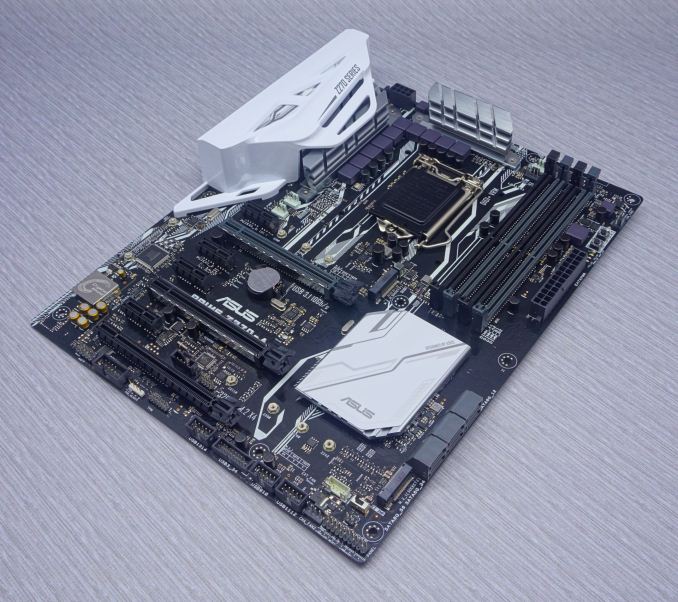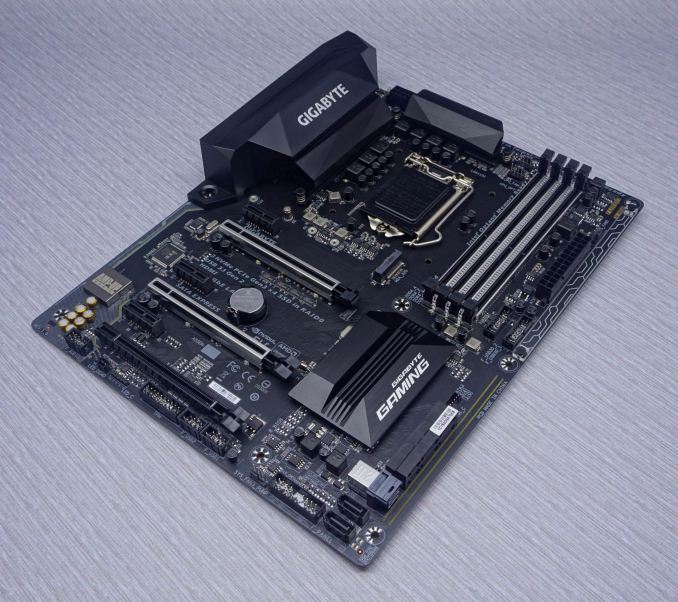The Asus Prime Z270-A & GIGABYTE Z270X-Ultra Gaming Motherboard Review
by E. Fylladitakis on July 18, 2017 10:45 AM ESTConclusion
Although both the Asus Prime Z270-A and the GIGABYTE Z270X-Ultra Gaming are similarly priced and targeted towards the same group of users, and even if both motherboards are sharing virtually the same subsystems, the approach that each manufacturer took is significantly different. Asus stuck with the features that benefit from high adoption rates, inserting two M.2 PCIe ×4 slots, with the third full-length PCIe slot being an additional high-speed storage device option. For the average gamer, the simultaneous support of two M.2 PCIe ×4 and six SATA drives probably is more than enough. GIGABYTE prioritized storage options and their performance, inserting a native U.2 PCIe ×4 and SATA Express ports that share no bandwidth with other devices, as well as a single M.2 slot. The third full-length PCIe slot can support an additional high-performance storage device, disabling two PCIe ×1 slots in the process, which will not affect the maximum number of storage devices that the motherboard can simultaneously support.
Both of the motherboards are sharing the same main primary subsystems. Both use the ASMedia 2142 controller, which provides one Type-A and one Type-C USB 3.1 Gen 2 port. Both boards use one Intel I219-V chip to provide a single RJ45 ethernet connection, and both use Realtek for the audio with an ALC1220/ALC1220A codec. All of these subsystems perform admirably, with the ALC1220 being a particularly good choice for a gaming-oriented motherboard. Asus placed a lot of effort on their implementation of the audio codec and the result was one of the best audio performance results that we have seen to this date, yet GIGABYTE does not fall far behind. As for CPU and gaming performance, we faced no issues with either of the motherboards that we reviewed here today. The overall CPU and gaming performance was almost identical during our testing, as both boards implemented Multi-Core Turbo by default.
GIGABYTE made the most out of the USB controllers, implementing a maximum of eight USB 3.1 Gen 1 (four internal and four at the back panel) and six USB 2.0/1.1 ports (four internal and two at the back panel). The Prime Z270-A respectively has six USB 3.1 Gen 1 (two internal and four at the back panel) and six USB 2.0/1.1 ports (internal headers only). Asus forgoes the USB 2.0 ports at the back panel, which should not be an issue considering that the USB 3.1 Gen 1 (USB 3.0) design requires it to be fully compatible with USB 2.0 devices. However, compatibility problems between old USB 2.0/1.1 devices and new USB 3.0/3.1 controllers are an uncommon, yet existent issue, with devices that are using RS-232 converters being the most frequent culprits. Both motherboards have an onboard Thunderbolt header. What the GIGABYTE Z270X-Ultra Gaming is lacking in comparison to the Asus Prime Z270-A is a COM header, which may be unimportant on a gaming motherboard, yet it could be a deterrent for certain users.
Aesthetics are a subjective matter and it falls upon each individual user to decide whether Asus’s design is too extravagant or GIGABYTE’s design is too dull. As far as RGB implementation goes, GIGABYTE took a more careful approach, with the inclusion of an RGBW/-UV header and a slightly more sophisticated application. This header can support regular RGB strips, RGBW strips (with extra white LEDs) or RGB/UV strips (with extra UV LEDs). The header on the Asus Prime Z270-A can support only RGB strips. The app for Asus’s RGB application, AURA, can sync lighting effects between all devices that support it (e.g. keyboards, DRAM and GPUs). The GIGABYTE RGB Fusion application is more flexible in terms of programming and control, and can also sync lighting effects between all devices supported by the RGB Fusion application.
We should not forget to mention that both of these motherboards feature 3D printing support, which is something of a trend lately. GIGABYTE’s approach on this is very rudimentary, offering 3D files and support only for the replacement of the LED overlay that lies across the right side of the motherboard. Asus took this quite more seriously and they are offering files for M.2 drive fan mounts, SLI bridge and cable covers, fan grills and cable combs. These files are editable of course, allowing users to perform modifications should they wish to do so. With 3D printers becoming more popular and affordable as time goes by, it would definitely be interesting to see more such ideas and options being implemented in the future.
Finally, when compared in terms of quality, both motherboards are up to task. GIGABYTE may have a slight psychological advantage here, as the Nippon Chemi-Con capacitors that the Z270X-Ultra Gaming is using are more popular than the Nichicon FPCAP capacitors found on the Asus Prime Z270-A. Both of these are top quality capacitor suppliers and the polymer products on both motherboards should easily last a decade, greatly surpassing the longevity of other parts. As both manufacturers also offer the same warranty length and terms, we ought to consider the comparison in terms of quality to be a tie. Where the Asus Prime Z270-A has an immense advantage is on the power delivery circuitry, which is significantly superior to what GIGABYTE implemented on the Z270X-Ultra Gaming, making the Prime Z270-A a far more appealing option for users who might look into heavier overclocking. GIGABYTE is mainly placing their faith on the native U.2 and SATA Express support, technologies that currently are not popular in the market, but still many users that do not upgrade or build new systems often may opt to have them just in case they gain traction in the future.












34 Comments
View All Comments
A5 - Tuesday, July 18, 2017 - link
A good comparison review of products that people will actually buy instead of the $500 monstrosities we normally see. Thanks.theuglyman0war - Friday, July 21, 2017 - link
The only reason I invested in flagship enthusiast bait was to bet on the components being built to last and stand up to harsh worst case scenarios.Considering they were built to handle punishment under ln2 extremes.
But they usually went on sale fairly quickly after the initial release. ( the rampage extreme III I am still sitting on I bought for well under $400 in about 3 months after release )
I assume those days are over?
Which is a shame considering the punishing volt experiementation and water accidents I have had...
Hedging my bets on the expensive caps and mosfets have seemingly bought me longevity to wait out this incremental expensive hell!
In the interim on client builds...
I been getting the mil spec bait instead.
A comparison between the mil spec branded stuff between gigabyte and asus would be interesting as well as an honest exploration whether as much is actually of a grade that might guarantee longevity/abuse? Or manufacturer ad nauseam abuse that offers no value compared to server grade branded stuff? ( asus prime ).
Is there a mil spec ansi standard that is legally meaningful?
The relative cheap price compared to the gaming flagship bait seems reasonable.
But I am not even sure about server grade claims? Compared to say...
The expense of Super Micro?
I close my eyes n just buy the cheapest "tuf" branded boards n cross my fingers.
OddFriendship8989 - Tuesday, July 18, 2017 - link
I can't comment about these two boards specifically, but I've used the Gaming K7 and Maximus IX Hero, and while I feel Gigabyte tends to be more generous in features, as someone who overclocks, I really need the Adaptive voltage setting that's missing from GIgabyte boards.RiZad - Tuesday, July 18, 2017 - link
"The default boot time of both the Asus Prime Z270-A and the GIGABYTE Z270X-Ultra Gaming is very good, with 12.6 seconds for the former and 13.4 seconds for the latter" something is wrong with the graph for that because thats not at all what is shown. it seems to have the default and stripped reversed. the other 2 points of comparison show default on top, stripped under.jbrl - Tuesday, July 18, 2017 - link
Would have really liked to see a comparison to a 170 board with the updated bios. Otherwise, why should I drop a few hundred extra on a new board?A5 - Tuesday, July 18, 2017 - link
If you're already on a Z170 board there is no reason to upgrade.jbrl - Tuesday, July 18, 2017 - link
Thanks, that is what I was thinking. I guess they can't put that in the review because asus will stop sending them samples.shabby - Tuesday, July 18, 2017 - link
Ultra gaming tactical pro sli ftw edition... this is getting a bit absurd.MajGenRelativity - Tuesday, July 18, 2017 - link
While there is certainly a proliferation of longer names, I feel these motherboard names are not excessively long. Sure, they could be shorter, but I feel that it doesn't give off an "Ultra gaming tactical pro sli ftw thor odin lightning edition" vibeBullwinkle J Moose - Tuesday, July 18, 2017 - link
Boot Times look Horrible!I wish Intel would streamline their chipset for speed
I remember how a 1st gen ATOM motherboard with IDE/serial and parallel ports and 2GB Max Ram booted several seconds faster than the 2nd Gen ATOM with 4GB Ram due to the chipset features
Faster CPU's require faster chipsets streamlined for speed freaks!
A stock install of Windows XP on a sammy 840 or 850 Pro boots in 3 seconds on a 35 Watt dualcore Sandy Bridge
A stock install of Windows 10 takes alsmost 10 seconds longer to boot on the same system
disregarding the O.S., chipset features and BIOS should advance with the CPU to match the boot speeds of ancient systems
Why is no-one questioning what is actually limiting the boot speeds on newer systems?
I don't think you can "really" fix this with a different brand of motherboard
We can see that some brands do better than others, but I would think that a sammy 960 Pro booting Win 10 on a new 4+Ghz quadcore CPU could (or should) beat an ancient dualcore system at half the clockspeed in boot times
After all, Win 7 was optimized and advertised as booting faster than XP
Win 8 was optimized and advertised as being faster than Win 7
and Windows Spyware Platform 10 was supposed to be faster than Windows 8.1
What gives?
This is DEFINITELY not fake news!